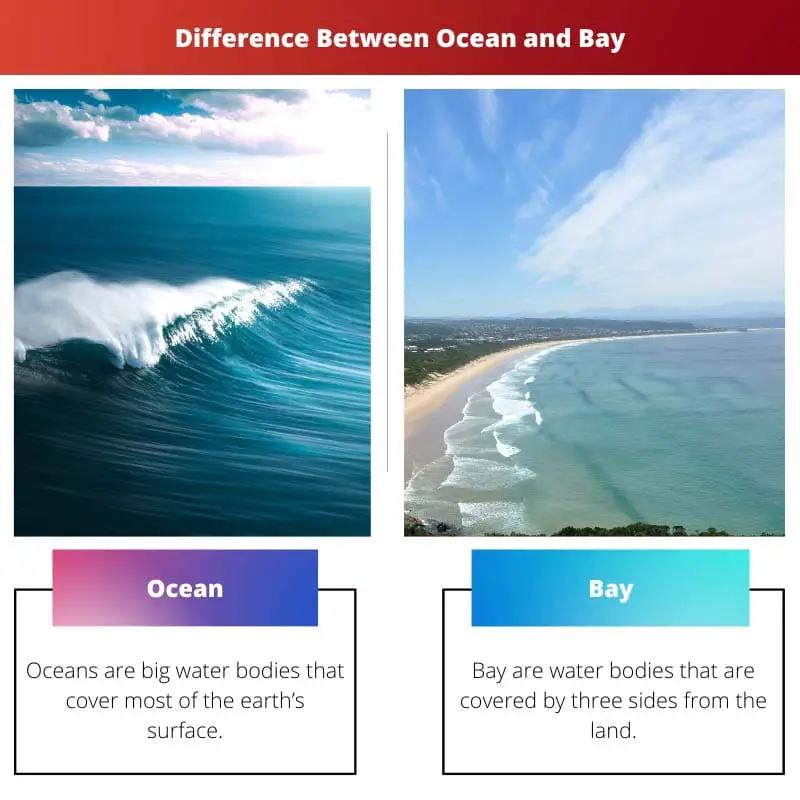The geography of planet Earth changes every few steps and sometimes becomes extreme compared to another.
Ocean and bay are both water bodies that differ in many contexts and can be seen as the same if seen from the corner of the land to the waters.
The shores depict the same story, but the deepest points can end differently.
Key Takeaways
- Oceans are vast bodies of saltwater that cover about 71% of Earth’s surface, while bays are smaller coastal areas partially enclosed by land.
- Bays provide calmer waters and shelter from harsh ocean conditions, making them ideal for harbors and ports.
- Due to their size and depth, ocean ecosystems are more diverse and complex than bay ecosystems.
Ocean vs Bay
An ocean is a large body of saltwater that covers more than 70% of the Earth’s surface. Oceans are vast and deep divided into five significant basins – the Atlantic, Indian, Southern, Arctic, and Pacific. A bay is a body of water that is partly enclosed by land. Bays are smaller than oceans and can be found along coastlines or at the mouth of rivers.

An ocean is a vast saltwater entity spaning roughly 71 % of the Earth’s surface. Although oceanographers and countries worldwide have traditionally split the sea into four distinct sections, there is only one global ocean.
Several oceanographers called the seas surrounding Antarctica the Southern Ocean in the early twentieth century, and National Geographic formally recognized this fifth ocean in 2021.
A bay is a recessed coastal body of water that connects to another significant body of water, such as a reservoir, ocean, or other bay.
A gulf is a vast bay also known as a bight, a sounding, or a sea. A cove is a small bay with a circular inlet, whereas steep basins have been created by glacial activity.
Comparison Table
What is Ocean?
The linked body of salt water covering the bulk of the Planet’s surface is referred to simply as “the ocean” and “the sea.” The Pacific, Atlantic, Indian, Southern, & Arctic Oceans are all included.
In Everyday Speech, “the ocean” and “the sea” are interchangeable, though not in Proper English. A “sea” is a body of water partially or entirely surrounded by land.
A mid-ocean ridge runs through every ocean basin, forming a long mountain range down in the ocean. They constitute the worldwide mid-oceanic ridge system, which includes the world’s most extended mountain range.
Most of the ocean is blue, although certain areas are blue-green, green, or perhaps even yellow to brown. Several elements contribute to the ocean’s blue colour.
To begin with, oceans absorb red light preferentially, leaving blue light behind to be thrown back out from the water. Because red light is the easiest to drink, it rarely reaches significant depths, less than 50 meters.
Blue light, on the other hand, can travel up to 200 meters. Second, in ocean water, molecules of water and tiny particles scatter blue light more than most other colours of light.
Even in the cleanest ocean water, blue light is scattered by water and small particles.

What is Bay?
A bay is a hollow, coastline body of water that links to a larger main body of water like an ocean, a swamp, or even another bay.
A gulf, sound, or bight is the common name for a vast bay. A narrow, round bay with a limited entrance is known as a cove. A fjord is a long, little bay formed by glacier activity.
A bay can be a river’s estuary, much like the Chesapeake Bay, an estuary of said Susquehanna River. Bays could also be nested within one other; for instance, James Bay in northern Canada is an arm of Hudson Bay.
The marine geology of several big bays, like the Bay of Bengal & Hudson Bay, is diverse.
Winds are reduced by the surrounding land, a bay, and waves are blocked. The shoreline characteristics of basins can be as diverse as those of other shorelines.
Because they provided safe fishing grounds, bays are essential in the history of human habitation. Later on, they played a vital role in the growth of marine trade since the safe harbour they offered their used as ports.
Bays can be formed in a variety of ways. Plate tectonics has resulted in the formation of the largest basins.
The continents migrated away when the supercontinent Pangaea split up along bent & indented fault lines, leaving huge bays such as the Guinea Gulf, Mexico Gulf, and the Bay of Bengal, the world’s largest bay.

Main Differences Between Ocean and Bay
- Oceans are large bodies of water that surround most of the Planet’s surface, whereas bays are smaller basins of water surrounded by land on three sides.
- The tides made in the ocean are bigger as compared to the tides which form in the bay.
- If the depth of the bay and the ocean is compared, then the Oceans are deeper than the Bay on the planet Earth’s geography.
- If the comparison is done based on the size and surface of water bodies. Oceans are much bigger as compared to the bay.
- The names of the oceans are the Pacific, Atlantic, Indian, and Arctic Ocean, whereas known bay includes Hudson Bay and the Bay of Bengal.





